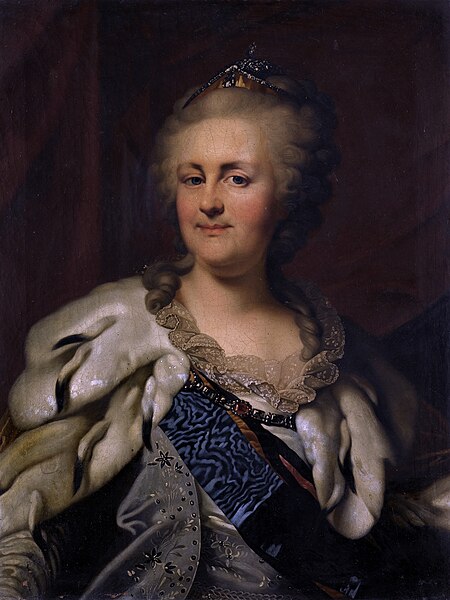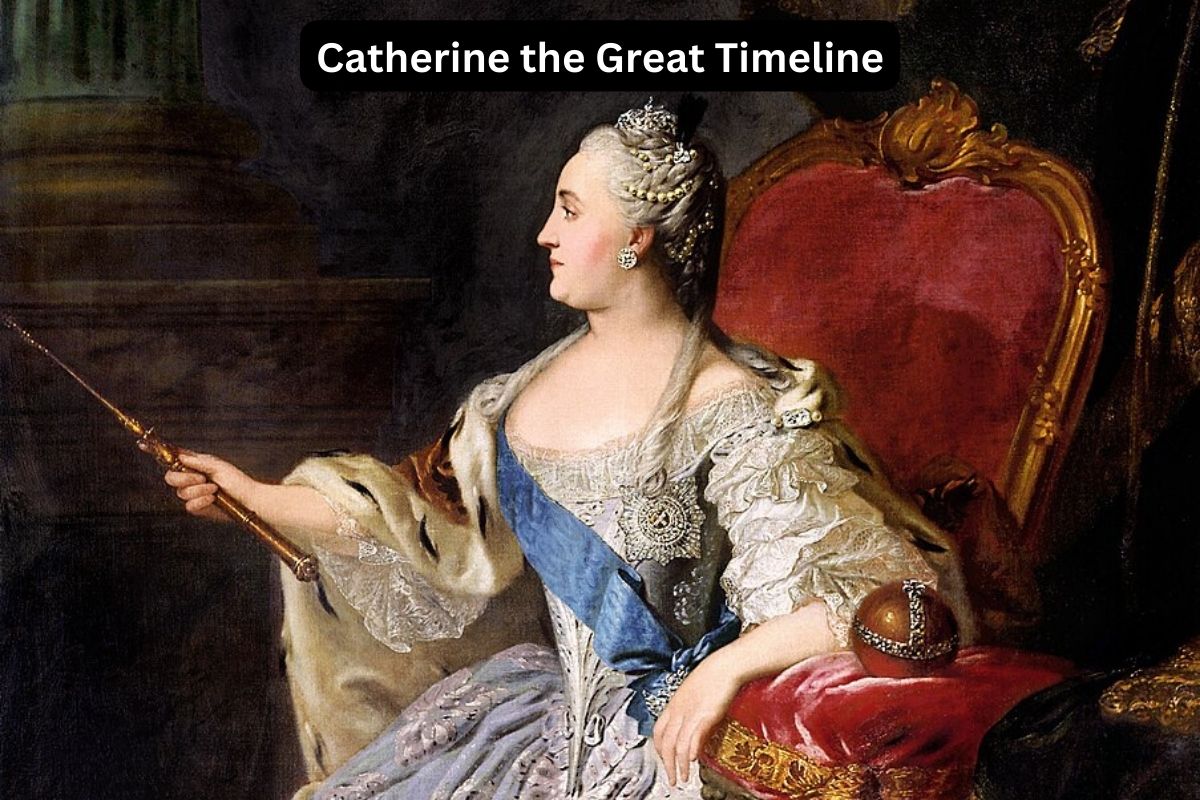Catherine the Great, also known as Catherine II, reigned as Empress of Russia from 1762 until her death in 1796. Her rule was marked by significant territorial expansion, administrative reforms, and cultural advancements, making her one of the most prominent figures in Russian history.
This article explores Catherine’s remarkable reign, from her rise to power through a coup against her husband, Peter III, to her ambitious reforms and diplomatic endeavors.
Delving into key events such as the Pugachev Rebellion and the annexation of Crimea, we uncover Catherine’s complex legacy as both a powerful ruler and a reformer who shaped the course of Russian history.
| Date | Event |
|---|---|
| May 2, 1729 | Catherine the Great was born in Stettin, Prussia (now Szczecin, Poland), as Sophie Friederike Auguste von Anhalt-Zerbst-Dornburg. |
| August 1745 | Sophie married Peter III of Russia, who later became Emperor Peter III. She converted to Russian Orthodoxy and took the name Catherine Alekseyevna. |
| July 9, 1762 | Peter III was overthrown in a coup led by Catherine. He was forced to abdicate, and Catherine became Empress of Russia. Peter III was later murdered, and Catherine’s reign began. |
| 1764-1767 | Catherine embarked on a series of administrative reforms, including the establishment of the Legislative Commission to review the laws of Russia. |
| 1767-1768 | Catherine issued the Charter to the Nobility, which confirmed the privileges of the nobles and reduced their obligations to the state. |
| 1768-1774 | The Russo-Turkish War occurred, resulting in significant territorial gains for Russia, particularly in the Black Sea region. |
| 1773-1775 | The Pugachev Rebellion took place, led by Cossack Emelyan Pugachev, who claimed to be Catherine’s late husband, Peter III. The rebellion was eventually suppressed, but it highlighted social and economic grievances in Russia. |
| 1776-1785 | Catherine implemented educational reforms, including the establishment of the Smolny Institute for Noble Maidens and the Commission of National Education. |
| 1783 | Crimea was annexed by Russia, further expanding Russian territory. |
| 1785-1796 | Catherine continued her territorial expansions and diplomatic endeavors, including wars against the Ottoman Empire and the partitioning of Poland. |
| November 17, 1796 | Catherine the Great died at the age of 67 in Tsarskoye Selo (now Pushkin), Russia. She was succeeded by her son, Paul I. |
Timeline of Catherine the Great
May 2, 1729: Catherine the Great was born in Stettin, Prussia
Catherine the Great, originally named Sophie Friederike Auguste von Anhalt-Zerbst-Dornburg, was born in Stettin, Prussia (now Szczecin, Poland). She was born into a minor German noble family and was later known as Catherine II.

August 1745: Sophie married Peter III of Russia, who later became Emperor Peter III
In August 1745, Sophie, now known as Catherine, married Peter III of Russia. Peter was the heir to the Russian throne and later became Emperor Peter III. The marriage was arranged by Empress Elizabeth of Russia, Peter’s aunt, in hopes of producing an heir to the Russian throne.
July 9, 1762: Peter III was overthrown in a coup led by Catherine
On July 9, 1762, Catherine led a coup against her husband, Peter III, who was widely unpopular among the Russian nobility and military.
Also Read: Catherine the Great Accomplishments
With the support of the Imperial Guard and other factions, Catherine forced Peter to abdicate the throne. Shortly afterward, Peter was arrested and later died under mysterious circumstances, leaving Catherine as the reigning Empress of Russia.
This event marked the beginning of Catherine’s reign, which would become one of the most significant periods in Russian history.
1764-1767: Catherine embarked on a series of administrative reforms
During this period, Catherine embarked on a series of administrative reforms aimed at modernizing Russia.
One of the notable reforms was the establishment of the Legislative Commission in 1767. This commission was tasked with reviewing the laws of Russia and proposing reforms to improve governance and administration.

1767-1768: Catherine issued the Charter to the Nobility
In 1767, Catherine issued the Charter to the Nobility, also known as the Charter of the Russian Nobility. This decree confirmed and expanded the privileges of the nobles, granting them greater autonomy and reducing their obligations to the state.
The charter solidified the nobility’s role as a privileged class in Russian society and was a significant step in Catherine’s efforts to maintain the support of the nobility.
1768-1774: The Russo-Turkish War occurred, resulting in significant territorial gains for Russia
The Russo-Turkish War of 1768-1774 was a conflict between the Russian Empire and the Ottoman Empire over territorial disputes in Eastern Europe and the Caucasus region. Catherine saw an opportunity to expand Russian influence in the Black Sea region and declared war on the Ottomans in 1768.
Also Read: Tsar Nicholas II Facts
The war resulted in significant territorial gains for Russia, including the acquisition of territories along the Black Sea coast and the establishment of Russian control over Crimea. The Treaty of Küçük Kaynarca in 1774 marked the end of the war and solidified Russia’s position as a major power in Eastern Europe.
1773-1775: The Pugachev Rebellion took place, led by Cossack Emelyan Pugachev, who claimed to be Catherine’s late husband, Peter III
The Pugachev Rebellion, led by Cossack Emelyan Pugachev, erupted in 1773 and lasted until 1775. Pugachev claimed to be Catherine’s late husband, Peter III, and rallied various disaffected groups, including peasants, Cossacks, and some nobles, against Catherine’s rule.
The rebellion highlighted widespread discontent with Catherine’s policies, particularly among the peasantry, who suffered from serfdom and harsh living conditions.
Although the rebellion was eventually suppressed, it exposed the weaknesses in Catherine’s regime and prompted her to enact some limited reforms.

1776-1785: Catherine implemented educational reforms, including the establishment of the Smolny Institute for Noble Maidens and the Commission of National Education
Catherine implemented significant educational reforms during this period aimed at modernizing Russia’s education system.
She established institutions such as the Smolny Institute for Noble Maidens in 1764, providing education for noble girls, and the Commission of National Education in 1779, which focused on improving primary and secondary education.
These reforms aimed to promote literacy and education among the Russian population and contribute to the cultural and intellectual development of the country.
1783: Crimea was annexed by Russia, further expanding Russian territory
In 1783, Catherine annexed Crimea, a strategic peninsula located on the northern coast of the Black Sea. The annexation followed years of conflict and diplomacy with the Ottoman Empire, which previously controlled Crimea.
The annexation of Crimea further expanded Russian territory and secured Russia’s control over the Black Sea region, strengthening its position as a major European power.

1785-1796: Catherine continued her territorial expansions and diplomatic endeavors
Throughout the latter part of Catherine’s reign, she continued to pursue territorial expansions and diplomatic initiatives aimed at strengthening Russia’s influence in Europe.
This period saw wars against the Ottoman Empire, such as the Russo-Turkish War of 1787-1792, which resulted in further territorial gains for Russia in the Caucasus and Eastern Europe.
Additionally, Catherine was involved in the partitioning of Poland, along with Austria and Prussia, which expanded Russian territory westward.
November 17, 1796: Catherine the Great died at the age of 67 in Tsarskoye Selo (now Pushkin), Russia
Catherine the Great passed away on November 17, 1796, at the age of 67, in Tsarskoye Selo (now Pushkin), Russia. Her death marked the end of a remarkable reign that saw significant territorial expansion, administrative reforms, and cultural advancements in Russia.
Catherine was succeeded by her son, Paul I, who inherited a vast and powerful Russian Empire shaped by his mother’s ambitious policies.
